The National Park Service (NPS) administers the National Park System, which covers 85 million acres of land and consists of 417 diverse units valued for their natural, cultural, and recreational importance. NPS generally receives appropriations in the annual Interior, Environment, and Related Agencies appropriations bill. This report examines trends in the agency's discretionary appropriations over the past decade (FY2009-FY2018) and related issues and congressional actions. It also discusses changes in the size of the National Park System, numbers of recreational visits to the parks, and NPS staffing levels during that period.
NPS Discretionary Appropriations Totals
NPS's discretionary appropriations fluctuated during the past decade (FY2009-FY2018). Appropriations in the decade's first and last years were highest, partially owing to supplemental appropriations in both years. With the supplementals included, discretionary appropriations totaled $3.276 billion in FY2009 and $3.460 billion in FY2018. The FY2018 figure was 5.6% higher than FY2009 in nominal dollars but 8.0% lower when adjusted for inflation (Figure 1 and Table 1).1 Excluding supplementals, NPS's FY2018 appropriations were 26.8% higher than FY2009 appropriations in nominal dollars and 10.5% higher in inflation-adjusted dollars. In either case, the main trend was decline in the first part of the decade and increase in the second part.
|
Figure 1. NPS Discretionary Appropriations, FY2009-FY2018 ($ billions, in nominal and inflation-adjusted 2009 dollars) |
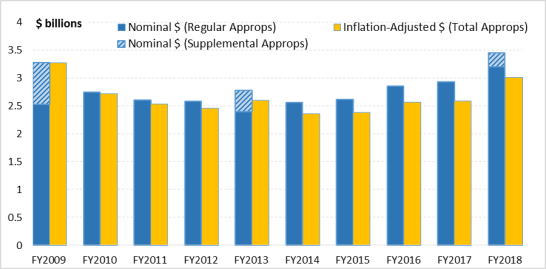 |
|
Sources: FY2009-FY2014 data are from annual House Appropriations Committee detailed tables for NPS. FY2015-FY2017 data are from NPS budget justifications for FY2017-FY2019. FY2018 data are from annual House Appropriations Committee detailed tables for NPS. Notes: See footnote 1 for additional information on this figure. |
Table 1. NPS Discretionary Appropriations, FY2009-FY2018
($ billions, in nominal and inflation-adjusted 2009 dollars)
|
Appropriation in Nominal $ |
Appropriation in Inflation-Adjusted 2009 $ |
% Change Since Previous Year |
||
|
Nominal |
Inflation-Adjusted |
|||
|
FY2009 |
3.276a |
3.276 |
— |
— |
|
FY2010 |
2.744 |
2.720 |
-16.2% |
-17.0% |
|
FY2011 |
2.611 |
2.537 |
-4.8% |
-6.7% |
|
FY2012 |
2.580 |
2.461 |
-1.2% |
-3.0% |
|
FY2013 |
2.775b |
2.604 |
+7.6% |
+5.8% |
|
FY2014 |
2.562 |
2.360 |
-7.7% |
-9.4% |
|
FY2015 |
2.616 |
2.382 |
+2.1% |
+0.9% |
|
FY2016 |
2.852 |
2.567 |
+9.0% |
+7.8% |
|
FY2017 |
2.932 |
2.595 |
+2.8% |
+1.1% |
|
FY2018 |
3.460c |
3.014 |
+9.2% |
+7.5% |
|
Total Change |
+0.184 |
-0.261 |
+5.6% |
-8.0% |
Sources: FY2009-FY2014 data are from annual House Appropriations Committee detailed tables for NPS. FY2015-FY2017 data are from NPS budget justifications for FY2017-FY2019. FY2018 data are from annual House Appropriations Committee detailed tables for NPS. Percentage calculations by CRS.
Notes: Data include supplemental appropriations. See footnote 1 for additional information on this table.
a. The FY2009 total of $3.276 billion includes regular appropriations of $2.526 billion and supplemental appropriations of $0.750 billion.
b. The FY2013 total of $2.775 billion includes regular appropriations of $2.398 billion and supplemental appropriations of $0.377 billion.
c. The FY2018 total of $3.460 billion includes regular appropriations of $3.202 billion and supplemental appropriations of $0.258 billion.
The supplemental appropriations consisted of economic stimulus measures in FY2009 (P.L. 111-5, the American Recovery and Reinvestment Act) and appropriations for hurricane recovery in FY2013 (P.L. 113-2) and FY2018 (P.L. 115-123). These funds were provided outside of regular appropriations laws and were not subject to discretionary spending caps.
Individual NPS Accounts
During the decade, NPS's appropriations were primarily organized in five accounts that cover basic park operations (Operation of the National Park System, or ONPS, account); construction and repair of infrastructure (Construction account); assistance to state, local, tribal, and private land managers (National Recreation and Preservation account); grants to states and localities for historic preservation (Historic Preservation Fund); and land acquisition by both NPS and the states (Land Acquisition and State Assistance account).2 By far the largest share of NPS's discretionary appropriations—72% in FY20183—went to the ONPS account, which covers basic park operations (Figure 2 and Table 2). In addition to these five accounts, during five years of the past decade (FY2010 and FY2015-FY2018), Congress appropriated funds for a sixth account, the Centennial Challenge account.4 The account provides the federal share of matching grants for "signature" park projects and programs, primarily aimed at addressing the agency's substantial backlog of deferred maintenance on its infrastructure.5
|
Mandatory Appropriations in the National Park Service's Budget Most of NPS's funding comes from discretionary appropriations, which are controlled by annual appropriations laws. However, NPS also receives mandatory appropriations under laws enacted by the authorizing committees, which allow the agency to spend money without further action by Congress. NPS's mandatory appropriations include recreation fees, concession franchise fees, receipts from leasing, and direct cash donations, among others. Altogether, for FY2018, NPS estimated mandatory funding of $0.708 billion, whereas the agency's discretionary appropriations for FY2018 were $3.460 billion (including supplemental funding). Based on the NPS estimates, mandatory appropriations would constitute approximately 17% of NPS's total FY2018 budget. In its FY2019 budget request, the Trump Administration included a legislative proposal to increase NPS's mandatory appropriations through the establishment of a Public Lands Infrastructure Fund, to be used for repairs and improvements in national parks, national wildlife refuges, and schools administered by the Bureau of Indian Education. One primary goal of the fund would be to address NPS's backlog of deferred maintenance, estimated at $11.6 billion for FY2017. The Administration's proposal was introduced in modified form in the 115th Congress as H.R. 5210 and S. 2509, the National Park Restoration Act. Under the bills, mandatory funding would go entirely to NPS (rather than to other bureaus in the Department of the Interior) for "priority deferred maintenance needs that support critical infrastructure and visitor services." The proposals would fund infrastructure needs from any onshore or offshore energy development revenues that the federal government receives above certain named thresholds over the next decade. Because future energy revenues are unknown, it is uncertain how much money, if any, would be generated for NPS. The House Natural Resources Committee held a hearing on H.R. 5210 on March 20, 2018. Other bills also have been introduced in the 115th Congress to provide mandatory funding from energy revenues for NPS deferred maintenance, including H.R. 2584, S. 751, and S. 3172. H.R. 2584, which also has received a House hearing, would deposit specified amounts from onshore and offshore mineral revenues each year through FY2047 for NPS deferred maintenance, in increasing amounts up to $500 million. The Obama Administration also sought changes in law that would significantly increase the mandatory spending available to NPS, again with a primary goal of addressing NPS's deferred maintenance backlog. Obama Administration budget requests proposed to more than double the agency's mandatory appropriations through various funds targeted to infrastructure and maintenance, and they also sought permanent funding for the Land and Water Conservation Fund, for land acquisition by NPS and other agencies. New mandatory spending would be subject to certain budget enforcement requirements, including the potential need to offset such spending. These requirements represent a hurdle for the above-described mandatory proposals. In the 114th Congress, H.R. 3556 and S. 2257 would have implemented many of the Obama Administration's requested changes, but neither bill was enacted. The 114th Congress did enact P.L. 114-289, which established the NPS Centennial Challenge Fund and an NPS Endowment. The law provided for a price increase for senior passes to the parks, with portions of the additional revenues directed to the Centennial Challenge Fund and the Endowment. This funding was provided as offsetting collections to annual appropriations. Deferred maintenance projects are a prioritized use of the funds. |
Table 2. NPS Appropriations by Account, FY2009-FY2018
($ millions, in nominal dollars and inflation-adjusted 2009 dollars)
|
ONPS |
Construction |
NR&P |
HPF |
LASA |
CC |
Totala |
|
|
FY2009 |
2,277.755b |
821.521b |
58.384 |
83.984b |
64.190 |
— |
3,275.834b |
|
FY2010 |
2,261.559 |
232.969 |
68.436 |
79.500 |
126.266 |
5.000c |
2,743.730 |
|
FY2011 |
2,250.050 |
184.646 |
57.245 |
54.391 |
94.810 |
— |
2,611.142 |
|
FY2012 |
2,236.568 |
155.366 |
59.879 |
55.910 |
101.897 |
— |
2,579.620 |
|
FY2013 |
2,097.261 |
453.885d |
56.747 |
100.486d |
96.567 |
— |
2,774.946d |
|
FY2014 |
2,236.753 |
137.461 |
60.795 |
56.410 |
98.100 |
— |
2,561.519 |
|
FY2015 |
2,277.485 |
138.339 |
63.117 |
56.410 |
98.960 |
10.000 |
2,616.501 |
|
FY2016 |
2,370.724 |
192.937 |
62.632 |
65.410 |
173.670 |
15.000 |
2,852.413 |
|
FY2017 |
2,425.120 |
209.353 |
62.638 |
80.910 |
162.029 |
20.000 |
2,932.120 |
|
FY2018 |
2,477.969 |
567.304 |
63.638 |
146.910 |
180.941 |
23.000 |
3,459.762e |
Sources: FY2009-FY2014 data are from annual House Appropriations Committee detailed tables for NPS. FY2015-FY2017 data are from NPS budget justifications for FY2017-FY2019. FY2018 data are from annual House Appropriations Committee detailed tables for NPS.
Notes: ONPS = Operation of the National Park System account; NR&P = National Recreation and Preservation account; HPF = Historic Preservation Fund account; LASA = Land Acquisition and State Assistance account; CC = Centennial Challenge account. Data include supplemental appropriations. See footnote 1 for additional information on this table.
a. Totals reflect annual rescissions for LWCF contract authority of $30.0 million for FY2005-FY2013 and $28.0 million for FY2014-FY2017. Because these rescissions are not included in the amounts for individual accounts, the figures for the individual accounts do not add up to the totals shown. Congress did not enact the rescission in FY2018 appropriations.
b. The FY2009 total of $3.276 billion includes regular appropriations of $2.526 billion and supplemental appropriations of $750.0 million. Supplemental FY2009 appropriations for specific accounts were $146.0 million for ONPS, $589.0 million for Construction, and $15.0 million for HPF.
c. For FY2010, the Centennial Challenge account was titled Park Partnership Project Grants.
d. The FY2013 total of $2.775 billion includes regular appropriations of $2.398 billion and supplemental appropriations of $377.3 million (after sequestration). Supplemental FY2013 appropriations for specific accounts (after sequestration) were $329.8 million for Construction and $47.5 million for HPF. See NPS budget justification for FY2015, with FY2013 final appropriations totals, at https://www.nps.gov/aboutus/upload/FY-2015-Greenbook-Linked.pdf.
e. The FY2018 total of $3.460 billion includes regular appropriations of $3.202 billion and supplemental appropriations of $257.6 million. Supplemental FY2018 appropriations for specific accounts were $207.6 million for Construction and $50.0 million for HPF.
|
Figure 2. NPS's FY2018 Discretionary Appropriations by Account |
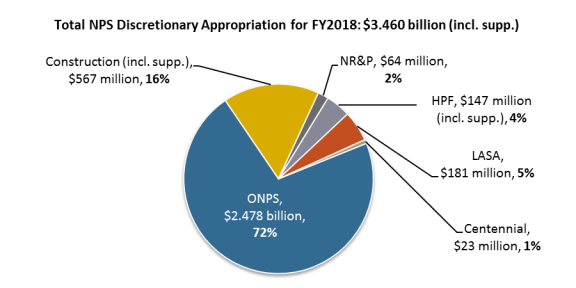 |
|
Source: P.L. 115-123; and P.L. 115-141, Division G, Explanatory Statement, Congressional Record, March 22, 2018, pp. H2609-H2694. Notes: ONPS = Operation of the National Park Service; NR&P = National Recreation and Preservation; HPF = Historic Preservation Fund; LASA = Land Acquisition and State Assistance. These data exclude permanent budget authorities and generally do not reflect scorekeeping adjustments. The data reflect supplemental appropriations for hurricane recovery in P.L. 115-123, including $207.6 million for the Construction account and $50.0 million for the HPF account. |
Operation of the National Park System Account
Appropriations for the largest NPS account, entitled Operation of the National Park System (ONPS), support the activities, programs, and services that form the day-to-day operations of the National Park System. Including supplemental appropriations for economic stimulus, ONPS funding was $2.278 billion in FY2009 and increased in nominal dollars to $2.478 billion in FY2018 (see Table 2 and Figure 3). When adjusted for inflation, however, this represents a decrease of 5.2%. With supplemental appropriations excluded, the FY2009 funding was less ($2.132 billion), and by this measure funding for the account increased over the decade in real terms, by 1.3% in inflation-adjusted dollars. As a percentage of total NPS appropriations, the ONPS share grew slightly over the decade if supplemental appropriations are counted, increasing from 69.5% of total funding in FY2009 to 71.6% in FY2018. Without supplementals, the ONPS share was 84% of total funding in FY2009 and 77% in FY2018, representing a decrease in share.
The majority of ONPS funds are provided directly to managers of individual park units. Activities covered under the account include visitor services, resource stewardship, park protection (including the U.S. Park Police), facility operations and maintenance, and park support,6 as well as "external administrative costs" for services provided by outside entities.7 Among these activities, funding for facility operations and maintenance, park support, and external administrative costs grew over the decade, whereas collective funding for the remaining activities—resource stewardship, visitor services, and park protection—declined.8 (These calculations do not reflect supplementals, because the supplemental funds were not assigned at the subaccount level.)
|
Figure 3. Appropriations for NPS's Operation of the National Park System (ONPS) Account, FY2009-FY2018 ($ millions, in nominal and inflation-adjusted 2009 dollars) |
 |
|
Sources: FY2009-FY2014 data are from annual House Appropriations Committee detailed tables for NPS. FY2015-FY2017 data are from NPS budget justifications for FY2017-FY2019. FY2018 data are from annual House Appropriations Committee detailed tables for NPS. Notes: See footnote 1 for additional information on this figure. |
Construction Account
The second-largest NPS account, titled Construction, funds new construction projects as well as repairs and improvements to existing facilities, among other activities. Appropriations to the account for the first and last years of the decade (FY2009 and FY2018), along with the appropriation for FY2013, were considerably higher than construction appropriations in intervening years, in all three cases owing to supplemental appropriations related to economic stimulus (FY2009) or hurricane recovery (FY2013 and FY2018). With the supplementals included and adjusting for inflation, the FY2018 appropriation was 39.8% lower than the FY2009 appropriation (see Figure 4 and Table 2). Construction appropriations accordingly represented a smaller portion of total NPS appropriations in FY2018 (16.4%) than they did in FY2009 (25.0%). Excluding supplementals, funding for the account grew over the decade by 34.8% in inflation-adjusted dollars, and Construction's share of total funding also rose (from 9.2% in FY2009 to 11.2% in FY2018).
|
Figure 4. Appropriations for NPS's Construction Account, FY2009-FY2018 ($ millions, in nominal and inflation-adjusted 2009 dollars) |
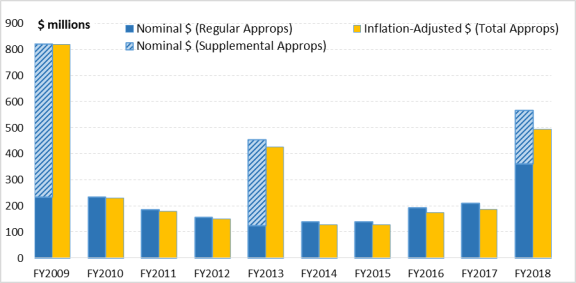 |
|
Sources: FY2009-FY2014 data are from annual House Appropriations Committee detailed tables for NPS. FY2015-FY2017 data are from NPS budget justifications for FY2017-FY2019. FY2018 data are from annual House Appropriations Committee detailed tables for NPS. Notes: See footnote 1 for additional information on this figure. |
|
NPS Infrastructure: Funding for Deferred Maintenance NPS's substantial backlog of deferred maintenance—infrastructure maintenance and repairs that were not performed as scheduled or as needed—has been an ongoing concern for Congress. The 115th Congress is considering NPS's infrastructure needs both within and outside the annual appropriations process. Despite the agency's efforts to reduce deferred maintenance through improved inventory and asset management, the NPS maintenance backlog has grown, as agency assets—many constructed in the early to mid-20th century—age and deteriorate, and needed maintenance and repairs are not performed. The backlog grew over the past decade from an estimated mid-range figure of $10.17 billion in FY2009 to an estimated $11.61 billion (in nominal dollars) in FY2017, the most recent year for which NPS estimates are available. The bulk of NPS deferred maintenance—51% in FY2017—is in transportation assets such as roads, bridges, and tunnels. Although discretionary appropriations provide a significant portion of the agency's funding to address deferred maintenance, such funding also comes from other sources. For example, road and bridge improvements are largely funded by allocations from the Department of Transportation. Funding to address deferred maintenance also may come through mandatory appropriations, such as fee collections. Within NPS's discretionary appropriations, two subaccounts provide the primary funding to address deferred maintenance: the line-item construction and maintenance activity within the Construction account and the facility operation and maintenance activity within the Operation of the National Park Service account. For more information on NPS deferred maintenance, see CRS Report R44924, The National Park Service's Maintenance Backlog: Frequently Asked Questions, by Laura B. Comay; and CRS Report R43997, Deferred Maintenance of Federal Land Management Agencies: FY2007-FY2016 Estimates and Issues, by Carol Hardy Vincent. |
Among the specific activities funded in the Construction account, the largest is line-item construction and maintenance, which covers construction of new facilities and rehabilitation and replacement of existing facilities.9 In recent years, NPS has planned no new facility construction, in order to prioritize deferred maintenance. Projects are prioritized based on their contribution to NPS mission factors and cost-benefit considerations.10 Other activities funded in the Construction account include emergency and unscheduled construction, repair and replacement of employee housing, dam safety, equipment replacement, construction planning and program management, development of general management plans for park units, and preparation of special studies of areas (for instance, to assess their potential for inclusion in the National Park System).
National Recreation and Preservation Account
The National Recreation and Preservation (NR&P) account funds NPS programs that primarily assist state, local, tribal, and private land managers with outdoor recreation planning, natural and cultural resource preservation, environmental compliance, and other activities outside the National Park System. Appropriations for the account ranged from $55 million to $65 million throughout the decade. Comparing FY2018 with FY2009 shows a growth in nominal dollars, from $58.4 million in FY2009 to $63.6 million in FY2018. Adjusted for inflation, however, this represents a decline of 5.0% (Figure 5 and Table 2). The portion of total NPS funding used for the NR&P account (1.8%) was the same at the beginning and end of the decade. The NR&P account was not affected by supplemental funding during the decade.
|
Figure 5. Appropriations for NPS's National Recreation and Preservation (NR&P) Account, FY2009-FY2018 ($ millions, in nominal and inflation-adjusted 2009 dollars) |
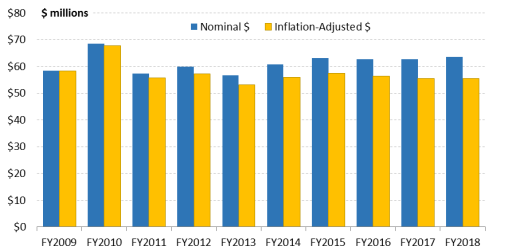 |
|
Sources: FY2009-FY2014 data are from annual House Appropriations Committee detailed tables for NPS. FY2015-FY2017 data are from NPS budget justifications for FY2017-FY2019. FY2018 data are from annual House Appropriations Committee detailed tables for NPS. Notes: See footnote 1 for additional information on this figure. |
A variety of natural, cultural, and recreational assistance programs are funded in the NR&P account. The Heritage Partnership Program, which provides NPS assistance to national heritage areas, is the largest single program in the account.11 Its appropriations grew over the decade in both nominal and inflation-adjusted dollars,12 despite budget requests from the Obama and Trump Administrations to significantly reduce it. The number of heritage areas also increased during the decade, from 39 to 49. The NR&P account also has included other programs that assist nonfederal entities, such as the American Battlefield Protection Program; Rivers, Trails, and Conservation Assistance Program; National Natural Landmarks and National Historic Landmarks Programs; National Register of Historic Places; and Preserve America Program. The account further covers international park affairs, environmental and compliance review, and grants administration.
Historic Preservation Fund
The Historic Preservation Fund (HPF), established in 1976,13 is administered by NPS through appropriations to the agency's HPF account. In accordance with the purposes of the National Historic Preservation Act (NHPA; P.L. 89-665; 54 U.S.C. §§300101 et seq.), the fund primarily provides grants-in-aid to state and tribal historic preservation offices for conservation of cultural and historical assets and sites. Grants are typically awarded on a 60% federal–40% state matching share basis. The HPF is funded by revenues from oil and gas activities on the U.S. outer continental shelf. Funding was reauthorized through FY2023 in P.L. 114-289.14
Appropriations for the HPF account varied during the decade and were highest in FY2013 ($100.4 million) and FY2018 ($146.9 million), in both cases due to supplemental appropriations for hurricane recovery (see Figure 6 and Table 2).15 This supplemental funding was primarily to assist recovering states and territories with compliance activities related to Section 106 of the NHPA. (Under Section 106, projects that receive federal funds or permits—such as many hurricane recovery projects—must be assessed for their potential effects on historic properties.) The account also received some supplemental funding as part of the economic stimulus package in FY2009. With supplementals included, the FY2018 appropriation was 52.4% higher in inflation-adjusted dollars than the FY2009 appropriation, and the account represented 2.6% of the total NPS appropriation in FY2009 and 4.2% in FY2018. With supplementals excluded, the FY2018 appropriation was 22.4% higher than in FY2009, and the account's share of total NPS appropriations was 2.7% in FY2009 and 3.0% in FY2018.
The largest activity in the account is funding for state historic preservation offices, which stayed relatively level (growth of +0.3%) in inflation-adjusted terms over the decade. (This does not include any supplemental funding, because none of the supplemental appropriations were assigned at the subaccount level.) Tribal grants rose by 42.9% after adjusting for inflation. At various points during the decade, the account also funded other grant programs, such as a competitive grant program for historically black colleges and universities (HBCUs) and the Save America's Treasures program to restore nationally significant historic structures and artifacts.
|
Figure 6. Appropriations for NPS's Historic Preservation Fund (HPF) Account, FY2009-FY2018 ($ millions, in nominal and inflation-adjusted 2009 dollars) |
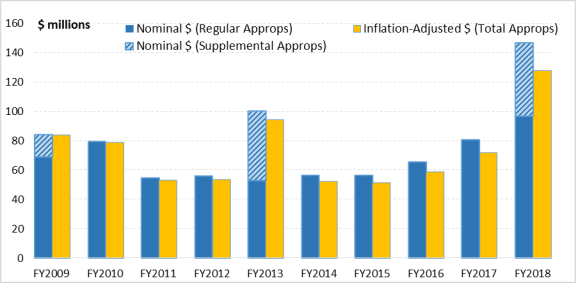 |
|
Sources: FY2009-FY2014 data are from annual House Appropriations Committee detailed tables for NPS. FY2015-FY2017 data are from NPS budget justifications for FY2017-FY2019. FY2018 data are from annual House Appropriations Committee detailed tables for NPS. Notes: See footnote 1 for additional information on this figure. |
Land Acquisition and State Assistance
The Land Acquisition and State Assistance (LASA) account represents NPS's share of appropriations from the Land and Water Conservation Fund (LWCF; 54 U.S.C. §§200301 et seq.). The LWCF is the primary funding source for land acquisition for the four major federal land management agencies—NPS, the Bureau of Land Management, the Fish and Wildlife Service, and the Forest Service.16 In addition, the LWCF supports grants to states (and, through states, to localities) for assistance with recreation planning, acquiring recreational lands and waters, and developing outdoor recreational facilities. These 50/50 matching grants, administered by NPS, generally are allocated to states by formula. In recent years, a portion of the funding ($20.0 million for FY2018, out of a total of $124.0 million for state assistance) also has been appropriated for a nationally competitive grant program. Overall, the LWCF is authorized at $900 million annually, but at no point in the past decade was this "full funding" appropriated.
Appropriations for the LASA account—comprising the NPS federal and state assistance portions of the LWCF—varied during the decade and rose overall, with the highest amounts appropriated in the past three years (see Figure 7 and Table 2). The appropriation rose from $64.2 million in FY2009 to $180.9 million in FY2018. (As with NR&P, supplemental appropriations did not affect the LASA account during the decade.) Adjusted for inflation, this is a growth of 145.6%. The growth is largely attributable to a significant increase in appropriations for state land acquisition in recent years. Altogether, the LASA account represented 2.0% of the total NPS appropriation in FY2009 and 5.2% in FY2018.
Both parts of the account—the funds for NPS land acquisition and for assistance to states—grew over the decade, but growth in the NPS portion was smaller (+9.8% in inflation-adjusted dollars) than in the state portion (+468.6%). State assistance was less than $20 million in FY2009, rose to roughly $40 million-$50 million annually for FY2010-FY2015, and more than doubled, reaching $110 million-$125 million, for FY2016-FY2018. For land acquisition by NPS, annual funding ranged between $45 million and $65 million, except in FY2010, when it rose to $86 million.
|
Figure 7. Appropriations for NPS's Land Acquisition and State Assistance (LASA) Account, FY2009-FY2018 ($ millions, in nominal and inflation-adjusted 2009 dollars) |
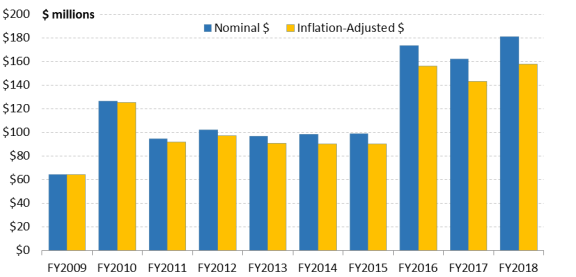 |
|
Sources: FY2009-FY2014 data are from annual House Appropriations Committee detailed tables for NPS. FY2015-FY2017 data are from NPS budget justifications for FY2017-FY2019. FY2018 data are from annual House Appropriations Committee detailed tables for NPS. Notes: See footnote 1 for additional information on this figure. |
Centennial Challenge
The Centennial Challenge account was funded during certain years of the decade (FY2010 and FY2015-FY2018). The account consists of a matching-grant program to spur partner donations for park improvements, primarily aimed at addressing deferred maintenance. The name "Centennial Challenge" indicates the fund's origin as a program to improve the parks in anticipation of NPS's 2016 centennial anniversary and its second century of park management. Both the Bush and Obama Administrations had proposed discretionary and mandatory funding for the fund prior to its legislative establishment in December 2016 (P.L. 114-289), and Congress had provided discretionary appropriations in some years, starting in FY2008. P.L. 114-289 codified the Centennial Challenge Fund and authorized it to receive federal revenues from certain sales of National Parks and Federal Recreational Lands Passes to seniors, in addition to discretionary appropriations. The senior pass revenues are provided as offsetting collections.17 Revenues are to be matched on at least a one-to-one basis by nonfederal donations.
During the past decade, Congress appropriated $5.0 million for the fund in 2010 and then did not make further appropriations until FY2015. Starting in that year, Congress appropriated increasing amounts, so that the FY2018 appropriation represented an increase of 120.1% over FY2015, and 304.3% over FY2010, in inflation-adjusted dollars. Still, the FY2018 appropriation, at $23.0 million, remained smaller than that for any other NPS account.18
|
Figure 8. Appropriations for NPS's Centennial Challenge Account, FY2009-FY2018 ($ millions, in nominal and inflation-adjusted 2009 dollars) |
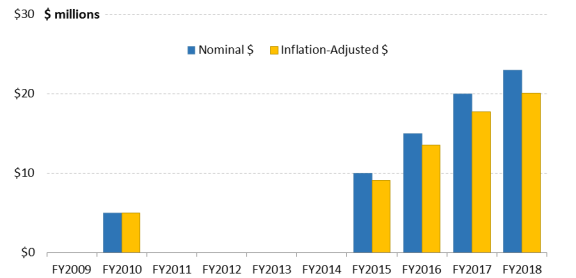 |
|
Sources: FY2009-FY2014 data are from annual House Appropriations Committee detailed tables for NPS. FY2015-FY2017 data are from NPS budget justifications for FY2017-FY2019. FY2018 data are from annual House Appropriations Committee detailed tables for NPS. Notes: See footnote 1 for additional information on this figure. |
NPS Appropriations in Context
Changes in NPS appropriations can be considered in the context of the National Park System's size, the number of visits to the parks, and NPS staffing levels, among other factors. Over the past decade, the acreage of the National Park System remained relatively stable, growing by 0.8%, while 26 new units were added. Visitation peaked in 2016 and was generally higher in the second part of the decade than the first. Staffing levels fluctuated around 20,000 during the past 10 years.
Size of the National Park System
National Park System acreage grew slightly over the decade, from 84.4 million acres to 85.0 million acres, a growth of 0.8%. (See Figure 9 and Table 3.) The percentage of National Park System lands owned by the federal government remained steady, at 95.3% of total system lands.19 The remainder—the nonfederal land in the system—includes lands within park boundaries that are owned by state or local governments and by private landowners.
Although the overall size of the National Park System did not change significantly, 26 units were added to the system in the FY2009-FY2018 period.20 Many were relatively small in acreage, such as Stonewall National Monument in New York (0.12 acres) and Belmont-Paul Women's Equality National Monument in Washington, DC (0.34 acres), which each consist of a single building. The largest units added to the system during the decade were Valles Caldera National Preserve (89,000 acres) and Katahdin Woods and Waters National Monument in Maine (87,563 acres). Other acreage changes resulted from boundary adjustments in existing parks.
|
Figure 9. Size of the National Park System, FY2009-FY2018 (in millions of acres) |
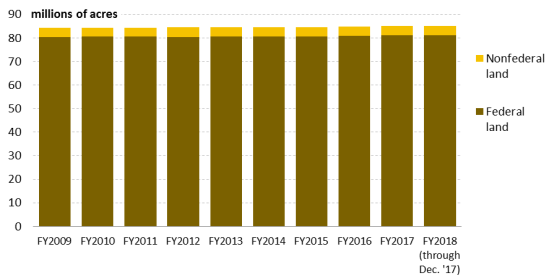 |
|
Sources: NPS Land Resources Division, annual summaries of acreage, available on NPS Stats web page at https://irma.nps.gov/Stats/Reports/National. FY2018 figures are as of December 31, 2017, the most recent data available. Notes: Federal Land category includes NPS Fee Acres, Less Than Fee Acres, and Other Federal Fee Acres. Nonfederal Land category includes Other Public Acres and Private Acres. |
|
Federal Land |
Nonfederal Land |
Total Acreage |
|
|
FY2009 |
80.438 |
3.938 |
84.375 |
|
FY2010 |
80.518 |
3.863 |
84.381 |
|
FY2011 |
80.485 |
3.900 |
84.385 |
|
FY2012 |
80.384 |
4.039 |
84.423 |
|
FY2013 |
80.473 |
4.007 |
84.479 |
|
FY2014 |
80.466 |
4.012 |
84.478 |
|
FY2015 |
80.598 |
4.021 |
84.616 |
|
FY2016 |
80.629 |
4.019 |
84.736 |
|
FY2017 |
81.008 |
4.031 |
85.039 |
|
FY2018 (through Dec. 2017) |
81.008 |
4.032 |
85.040 |
Sources: NPS Land Resources Division, annual summaries of acreage, available on NPS Stats web page at https://irma.nps.gov/Stats/Reports/National. FY2018 figures are as of December 31, 2017, the most recent data available.
Notes: Federal Land category includes NPS Fee Acres, Less Than Fee Acres, and Other Federal Fee Acres. Nonfederal Land category includes Other Public Acres and Private Acres.
Visits to the National Parks
Numbers of recreational visits to the National Park System varied over the past 10 years but were generally higher toward the end of the decade. The highest numbers of visits were in 2016 (331.0 million visits) and 2017 (330.9 million visits; see Figure 10 and Table 4). Visits at the end of the decade were 15.9% higher than at the beginning.21
Table 4. Annual Recreational Visits to the National Park System, 2009-2018
(total visits by calendar year)
|
Year |
Number of Visits |
Year |
Number of Visits |
|
2009 |
285.6 |
2014 |
292.8 |
|
2010 |
281.3 |
2015 |
307.2 |
|
2011 |
278.9 |
2016 |
331.0 |
|
2012 |
282.8 |
2017 |
330.9 |
|
2013 |
273.6 |
2018 (thr. May) |
104.4 |
Source: NPS, NPS Stats, at https://irma.nps.gov/Stats/Reports/National.
Notes: The figure for 2018 shows visits through May 2018. For comparison with the previous year, visits through May 2017 were higher at 110.3 million.
|
Figure 10. Annual Recreational Visits to the National Park System, 2009-2018 (total visits in millions, by calendar year) |
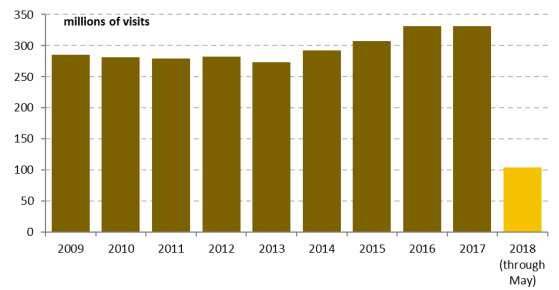 |
|
Source: National Park Service, NPS Stats, at https://irma.nps.gov/Stats/Reports/National. Notes: The figure for 2018 shows visits through May 2018 (104.4 million visits). For comparison with the previous year, visits through May 2017 totaled 110.3 million. |
National Park Service Staffing
NPS's full-time equivalent (FTE) staffing levels were highest in the earlier part of the decade, starting with an FY2010 increase that followed economic stimulus measures in FY2009. Staffing ranged from a high of 22,211 in FY2010 to a low of 19,359 in FY2015 (Figure 11 and Table 5). NPS's staffing estimate for FY2018 would appear to be the second-lowest, but it may not fully capture staffing numbers because it was based on an appropriations baseline derived from a continuing resolution, whereas the final NPS appropriation was higher.
|
Year |
Number of FTEs |
Year |
Number of FTEs |
|
FY2009 |
20,991 |
FY2014 |
19,894 |
|
FY2010 |
22,211 |
FY2015 |
19,359 |
|
FY2011 |
22,051 |
FY2016 |
19,722 |
|
FY2012 |
21,830 |
FY2017 |
19,668 |
|
FY2013 |
20,720 |
FY2018 (est.) |
19,520 |
Sources: FY2009-FY2015 numbers from U.S. Department of the Interior, "Department of the Interior FTE History: Full-Time Equivalent Staff Year (FTE) Actual of Bureaus and Offices," at https://www.doi.gov/sites/doi.gov/files/uploads/fte-_history_table-20161108.pdf. FY2016-FY2018 numbers from NPS budget justifications.
Note: NPS's FTE estimate for FY2018 was based on an appropriations baseline of $2.924 billion derived from a continuing resolution, whereas the final NPS appropriation was $3.202 billion, not including supplementals.
|
Figure 11. NPS Full-Time Equivalent (FTE) Staff, FY2007-FY2016 |
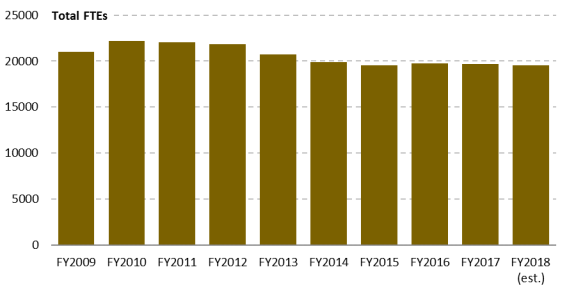 |
|
Sources: FY2009-FY2015 numbers from U.S. Department of the Interior, "Department of the Interior FTE History: Full-Time Equivalent Staff Year (FTE) Actual of Bureaus and Offices," at https://www.doi.gov/sites/doi.gov/files/uploads/fte-_history_table-20161108.pdf. FY2016-FY2018 numbers from NPS budget justifications. Note: NPS's FTE estimate for FY2018 was based on an appropriations baseline of $2.924 billion derived from a continuing resolution, whereas the final NPS appropriation was $3.202 billion, not including supplementals. |
Conclusion
NPS's appropriations fluctuated over the past decade, and supplemental appropriations notably increased the totals in FY2009, FY2013, and FY2018. Counting the supplementals, the total NPS discretionary appropriation for FY2018 was 5.6% higher than FY2009 in nominal dollars but 8.0% lower in inflation-adjusted dollars. Excluding supplementals, the FY2018 appropriation was higher than FY2009 in both nominal (+26.8%) and inflation-adjusted (+10.5%) dollars. The overall trend was one of decline in the first part of the decade and growth in the second part. The share of total appropriations represented by each individual account in the NPS portfolio also fluctuated, and overall changes in share vary depending on whether or not supplemental appropriations are counted.
The funding changes took place in the context of a park system of relatively stable size and a staffing level that hovered around 20,000. Although park acreage grew only slightly, 26 units were added to the system during the decade. Visits to the parks generally were higher in the second half of the decade than the first and peaked in 2016 at approximately 331 million visits.
A major funding issue for NPS is infrastructure reinvestment. The agency's backlog of deferred maintenance and repairs for its infrastructure was estimated at $11.61 billion for FY2017. Funding for both of the discretionary appropriations accounts that mainly address deferred maintenance (ONPS and Construction) decreased over the decade if supplementals are counted in the measurement but increased if supplementals are excluded. NPS's infrastructure needs continue to receive attention in the 115th Congress, both within and outside the annual appropriations process.